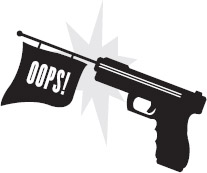Uncle John’s Bathroom Reader Zipper Accidents (14 page)
Read Uncle John’s Bathroom Reader Zipper Accidents Online
Authors: Uncle John’s


By 2000 the company was already starting to lose value, but company leaders were offered the chance to purchase a new player on the movie rental scene: Netflix, which rented out DVDs via mail at a flat, monthly cost—with no late fees like the ones Blockbuster made millions from. (It’s corporate legend, but Netflix founder Reed Hastings supposedly got the idea to start the company after returning
Apollo 13
to a Blockbuster six weeks late and paying a $40 late fee.)
Speculators saw great potential in Netflix. The young company was offered to Blockbuster for
$50 million—a price many analysts at the time called a bargain. But Blockbuster’s corporate brass balked at the price and turned the deal down, instead spending millions in 2000 on a 20-year-deal to distribute movies digitally with a media subsidiary of the oil company Enron.
Yes,
that
Enron. The oil giant that went down in flames in a well-publicized accounting scandal about a year later, bringing down hordes of investors, executives, and deals along with it…including the one with Blockbuster.
Netflix, meanwhile, turned its first profit of $6.5 million in 2003 and was valued at about $4 billion in late 2012. But the choice to not purchase Netflix was just one bad decision in a series of missteps and bad luck for Blockbuster, including the launch of fresh competitors like the kiosk DVD rental company Redbox. Blockbuster tried an online subscription service, its own kiosk service, a “no-late-fee” policy (an advertising ploy that led to investigations for misrepresentation, resulting in the irony of a $650,000 fee for Blockbuster), and even a baffling bid to buy the struggling Circuit City. All these efforts failed to save the company. Plans to file Chapter 11 bankruptcy were announced in late 2010, and the remains of the company were purchased by Dish Network in 2011. Most stores were shuttered.
C
an’t be beat!
Apple isn’t the only company that makes personal digital music players. German company TrekStor entered the market in 2007, and, capitalizing on Apple’s tendency to put “i” in the name of its products (iPhone, iPod, iPad, etc.), TrekStor called its device the i.Beat (as in beats, because it’s a music player, get it?). However, the device was also colored black, leading TrekStor to release to the world a product called i.Beat.blaxx. Perhaps because of a language barrier, TrekStor was flummoxed by the outcry, and the company’s president issued a press release stating that “beat” referred to music, not violence. Nevertheless, the company renamed the device the TrekStor blaxx.


Definitely unique.
In 2012 Adidas announced plans for an athletic shoe that came with rubber shackles attached (shoe goes on the foot, shackle goes on the leg, for support or something). After many people on the Internet pointed out that foot shackles are primarily associated with slavery, and that basketball shoes have a large African-American customer base, Adidas pulled the shoe, but defended the design as “outrageous and unique.”
McStupid.
In 2002 a severe drought led to widespread famine in Africa—not the first time the continent had been ravaged by starvation. Somehow unaware of this, that same year McDonald’s locations in Norway began selling a sandwich called the McAfrika, an “African-inspired” sandwich composed of pita bread, beef, and vegetables. After thousands of complaints and public shaming in the media, McDonald’s pulled the sandwich and put famine relief donation boxes in its Norwegian outlets to help the estimated 12 million starving people in Africa at the time.
Bad Barbie.
There have been hundreds of Barbie dolls released over the past several decades. In 1997 Barbie maker Mattel, in tandem with Nabisco, released an Oreo-branded Barbie to promote the popular cookie. The fact that Barbie’s dimensions, if applied to a real woman, would negate the possibility of eating anything, let alone junk food, is not the most offensive aspect of this ill-advised marketing scheme. Mattel releases Caucasian and African-American versions of almost all of its Barbie dolls, and it did so with the Oreo-loving Barbie. Thus, a black “Oreo Barbie” made it to the market. Evidently neither corporation was familiar with the slang term “oreo,” a derogatory term for a black person that means “black on the outside, white on the inside,” like an Oreo, a way of calling a black person a sellout or accusing them of “acting white.” (The doll was recalled.)
Sour milk.
Dairy Queen introduced its version of the Starbucks Frappuccino in 2004. A combination of vanilla soft-serve ice cream and coffee, it was called the MooLatte, because it was a combination of dairy products (moo) and fancy coffee (latte). MooLatte, however, is very similar to the word mulatto, an outdated and offensive word that means “of mixed race.” Dairy Queen apologized… but has kept the MooLatte on its menu to this day.
Not o-k-k-k.
A 2011 alumni magazine for a University of Kentucky sorority ran a picture of three women in matching Kentucky tank tops, along with the caption “Sisters cheer for the Wildcats at a Kentucky football game.” More than 200,000 readers saw the picture of three young, white women whose shirts spelled out “KKK.”
The facts of “Life.”
Quaker’s Life cereal comes in several varieties. The “regular” variety is packaged in a white box, and features a Caucasian woman and boy. Life’s maple and brown sugar flavor comes in a brown box and shows two African American children.
Looney Zune.
In 2006 Microsoft debuted the Zune, an MP3 player designed to compete with Apple’s iPod. The name “Zune” was meant to sound like futuristic nonsense…until Hebrew scholars pointed out its similarity to the Hebrew
zi-yun
, which is basically that language’s F-word.
C
lement Vallandigham was a 19th-century Ohio congressman and, during the Civil War, a leader of the little-known Copperheads faction: antiwar, pro-Confederate Democrats from the North. During the war, he was charged with treason, but President Lincoln commuted his two-year prison sentence to exile to the South. After the war, Vallandigham returned to Ohio and started a law practice. The night before a trial was to begin in 1871, Vallandigham was demonstrating to some of his law partners that his client, Thomas McGehan, was innocent of shooting Tom Myers to death, and that Myers had really shot himself.


So Vallandigham put a pistol in his pocket, pulled it out, cocked it…and shot himself, the same way he alleged that Myers had. McGehan was acquitted of murder, but he was represented by another lawyer, because Vallandigham had, evidently like Myers, accidentally shot and killed himself.
K
NOT FOOLED
In 2003 a Pennsylvania family dressed their seven-year-old son in a Cub Scout uniform and sent him door-to-door to collect donations for his troop. Except that he wasn’t really a Cub Scout—it was a scam, of course. They visited more than 150 homes and had earned $667 before they got caught. They knocked on the door of an Eagle Scout, who knew something was up when he saw a Cub Scout with a knotted kerchief. Cub Scouts use scarf slides, not knots.
FOOL ME ONCE…
In 1990 Charles J. Bazarian was convicted of swindling hundreds of thousands of dollars, which lead to the collapse of five savings-and-loan banks. He was prosecuted in Irvine, California. Three years later, as part of another swindling spree, Bazarian convinced the prosecutor who convicted him in 1990 to invest $6,000 in what turned out to be a fraudulent business.
CLICK? CLINK.
In 1993, 24-year-old David Bridges broke into a home in Grapevine, Texas, and stole a television. He probably would have gotten away with it, too, had he not returned to the home, where police were waiting, to retrieve the TV’s remote control.
CUSTOMER SERVICE
Most bank robbers disguise themselves before they commit the crime. Others simply go to a place where they wouldn’t be recognized. And then there’s the woman who in October 2012 went on a string of bank robberies in the Boston area. One of the banks she hit was the bank where she has an account. The teller she held up recognized her, called her by name, and easily led the cops to her home.
